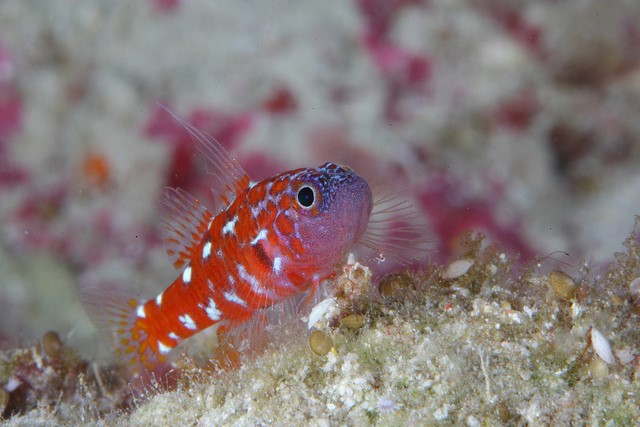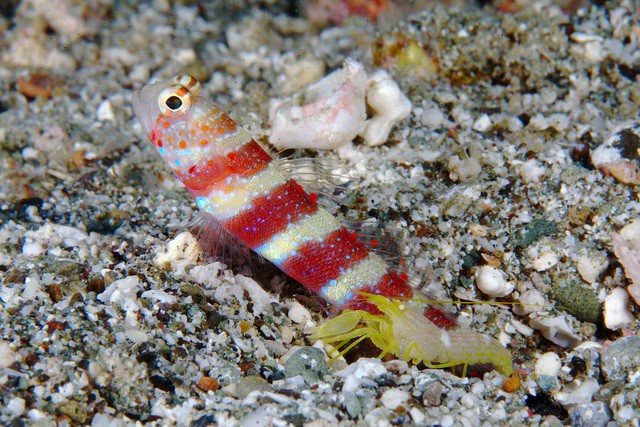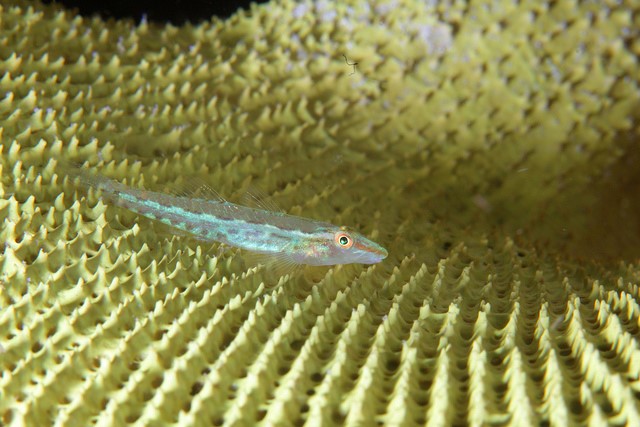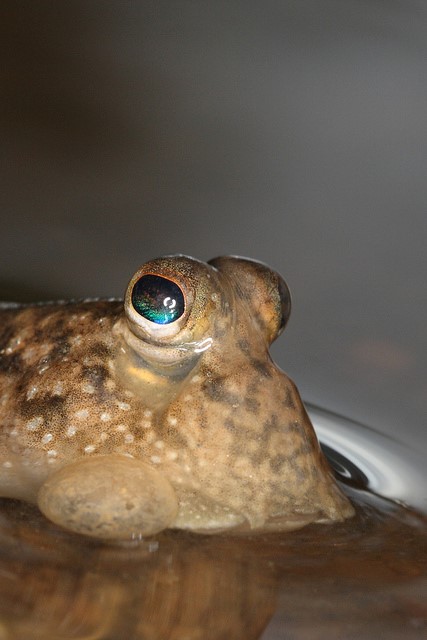By guest blogger Dr. Klaus M. Stiefel
Gobyphilia — what is that? Is that even legal? It’s the love of gobies, and it’s widespread among scuba divers and especially macro-loving underwater photographers. I have it, and I hope you’ll get it too after reading this article.
The gobies are a family of small bony fishes. Most of them are marine, even though gobies also populate brackish and freshwater. Gobies are one of the most diverse fish families, with 1,691 species listed on Fishbase.
Many of them are amazing, tiny aquatic jewels, with astonishing colors and patterns on their bodies. And tiny they are, with the adults of the smallest species reaching less than a centimeter in length, rivaling certain frogs, carp and anglerfish as the smallest vertebrates.

Since gobies are so tiny, and many of the world’s reefs below recreational diving depths are still poorly explored, new goby species pop up all the time. So I was excited, but not surprised, to photograph two goby species so far undescribed by science during a survey of the gobies of Malapascua Island in the Philippines in 2011 at a depth of 197 feet (60 meters).
Gobies live in a variety of ways. Some are sand-dwellers; some are solitary; some live in groups or in pairs. Some of the paired sand-gobies work as teams: while one fish takes in a mouthful of sand in search of edibles, the other fish cautiously looks around for threats. Other gobies spend most of their lives among select invertebrate hosts, like soft corals, hard corals or sponges. The next time you dive along a tropical coral reef, slow down and carefully scan the inside of a sponge, the pinkish stem of a soft coral, or the crevices in-between the fingers of a hard-coral for tiny, fast-moving fish. You might very likely find a few small gobies darting around in these locations, colored and patterned to exquisitely match their host animals. Such commensalism — the use of one animal (the corals and sponges) by another (the gobies) for its benefit — is common among gobies. So is symbiosis, the teamwork between animals: if you are small, you need a partner.

A fascinating type of goby symbiosis involves partnering with a shrimp. In this symbiosis, the shrimp uses its powerful claws to dig a burrow in the sand, which it shares with the goby. But the shrimp has very poor eyesight, and would quickly fall prey to a sand-prowling predator if not for the goby’s services as a watchman. The fish sets himself up at the entrance of the burrow and keeps a close watch on everyone approaching the shared home, including divers with clumsy buoyancy. At all times when the shrimp leaves the burrow to dump some sand from its tunnels, the crustacean keeps one of its antennae in touch with the goby’s body. If the goby sees something it considers a possible threat, it first wiggles its tail to warn the shrimp, which then stays underground. A greater or more closely approaching danger causes the goby to escape into the shared tunnel in a split-second. Then, it will take a few minutes before the goby carefully sticks its head out again, to be followed by a full emergence of the shrimp and a resumption of normal digging operations. Without the other partner, neither the shrimp nor the goby would manage to live in the otherwise unprotected sandy plains between coral bommies. It takes a lot of patience, but watching this symbiosis in action is remarkable.

Another fascinating group of gobies are the mudskippers: amphibious gobies. The next time you stay in a tropical island resort, don’t just ignore the mangroves as the “stinky trees behind the village.” Check out this fascinating ecosystem, and keep your eyes focused on the ground where the seawater meets the mud: you will likely see the mudskippers jumping around in small groups, hiding behind the mangrove roots, darting between the shallow water and the mud, and socializing the way you can only do it in the mud. Their pectoral fins feature special evolutionary adaptations that make them useful for locomotion on land, and changes to their respiratory system allow them to stay out of the water for considerable amounts of time. These land-gobies have sharp eyes and good reflexes, so in order to observe and photograph them you will have to approach them very slow and calmly.

Everyone loves to see impressive sharks when diving. I have, on one occasion missed a thresher shark, during a tech dive at 262 feet (80 meters). The reason? I saw a goby species that I had not seen before (belonging to the genus Trimma). I have no regrets from missing the large ocean predator to check out the brilliant small fish: now that’s a man with severe gobyphilia speaking.

